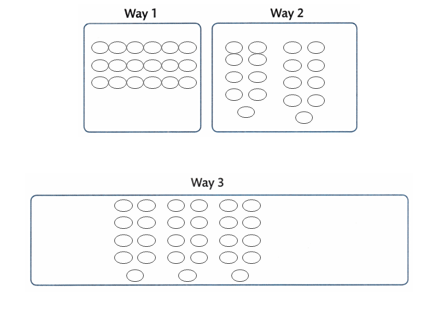Practice with the help of enVision Math Common Core Grade 3 Answer Key Topic 1 Understand Multiplication and Division of Whole Numbers regularly and improve your accuracy in solving questions.
enVision Math Common Core 2nd Grade Answers Key Topic 1 Understand Multiplication and Division of Whole Numbers
Essential Question: How can thinking about equal groups help you understand the connection between multiplication and division?

enVision STEM Project: Forming Groups
Do Research Many types of animals form groups. Use the Internet or other sources to discover which animals form groups. Why do they do this? What are the benefits for these animals of being in a group?
Journal: Write a Report Include what you found. Also in your report:
- Draw representations of animals in equal groups. Give a reason why those animals formed groups.
- Use a multiplication equation to show the total number of animals. Use a division equation to show the number of animals in each group.
Review What You Know
• add
• subtract
• skip count
• ones
Vocabulary
Choose the best term from the box. Write it on the blank.
Question 1.
If you combine different sized groups to find how many in all, you ___.
Answer:
To find how many in all we can use the term add.
Explanation:
In the above-given question,
given that,
choose the best term from the box.
In the box, they gave the four words.
they are added, subtract, skip count, and ones.
so I am choosing the term to add.
the meaning of combine is to add.
example:
In group A there are 3 rats.
In group B there are 4 rats.
so to find how many rats are there in two groups?
we will use the term add.
3 + 4 = 7.
Question 2.
___ are groups of single objects.
Answer:
Ones are groups of single objects.
Explanation:
In the above-given question,
given that,
choose the best term from the box.
In the box, they gave the four words.
they are added, subtract, skip count, and ones.
so I am choosing the term ones.
example:
if there is a rat in group A.
we will say that there is only one rat.
so we will use the term ones for a single object.
Question 3.
When you say the numbers 5, 10, 15, 20, you ___.
Answer:
We use the term skip count when the numbers are skipping by 5.
Explanation:
In the above-given question,
given that,
choose the best term from the box.
In the box, they gave the four words.
they are added, subtract, skip count, and ones.
so I am choosing the word skip count.
example:
if they gave the numbers 5, 10, 15, and 20.
we will say that the numbers are skipping by 5.
so we will use the term skip count.
Adding
Find each sum.
Question 4.
5 + 5 + 5 = ?
Answer:
5 + 5 + 5 = 15.
Explanation:
In the above-given question,
given that,
find the sum of numbers.
5 + 5 + 5.
5 + 5 = 10.
10 + 5 = 15.
so 5 + 5 + 5 = 15.
Question 5.
7 + 7 = ?
Answer:
7 + 7 = 14.
Explanation:
In the above-given question,
given that,
find the sum of numbers.
7 + 7.
7 + 7 = 14.
so 7 + 7 = 14.
Question 6.
3 + 3 + 3 = ?
Answer:
3 + 3 + 3 = 9.
Explanation:
In the above-given question,
given that,
find the sum of numbers.
3 + 3 + 3.
3 + 3 = 6.
6 + 3 = 9.
so 3 + 3 + 3 = 9.
Question 7.
2 + 2 + 2 + 2 = ?
Answer:
2 + 2 + 2 + 2 = 8.
Explanation:
In the above-given question,
given that,
find the sum of numbers.
2 + 2 + 2 + 2.
2 + 2 = 4.
4 + 2 = 6.
6 + 2 = 8.
so 2 + 2 + 2 + 2 = 8.
Question 8.
6 + 6 + 6 = ?
Answer:
6 + 6 + 6 = 18.
Explanation:
In the above-given question,
given that,
find the sum of numbers.
6 + 6 + 6.
6 + 6 = 12.
12 + 6 = 18.
so 6 + 6 + 6 = 8.
Question 9.
9 + 9 + 9 = ?
Answer:
9 + 9 + 9 = 27.
Explanation:
In the above-given question,
given that,
find the sum of numbers.
9 + 9 + 9.
9 + 9 = 18.
18 + 9 = 27.
so 9 + 9 + 9 = 27.
Subtracting
Find each difference.
Question 10.
21 – 7 = ?
14 – 7 = ?
7 – 7 = ?
Answer:
21 – 7 = 14.
14 – 7 = 7.
7 – 7 = 0.
Explanation:
In the above-given question,
given that,
find the difference of two numbers.
21 – 7 = 14.
14 – 7 = 7.
7 – 7 = 0.
In the given question the numbers are increasing by 7.
0 + 7 = 7.
7 + 7 = 14.
14 + 7 = 21.
Question 11.
15 – 5 = ?
10 – 5 = ?
5 – 5= ?
Answer:
15 – 5 = 10.
10 – 5 = 5.
5 – 5 = 0.
Explanation:
In the above-given question,
given that,
find the difference of two numbers.
15 – 5 = 10.
10 – 5 = 5.
5 – 5 = 0.
In the given question, the numbers are increasing by 5.
0 + 5 = 5.
5 + 5 = 10.
10 + 5 = 15.
Question 12.
27 – 9 = ?
18 – 9 = ?
9 – 9 = ?
Answer:
27 – 9 = 18.
18 – 9 = 9.
9 – 9 = 0.
Explanation:
In the above-given question,
given that,
find the difference of two numbers.
27 – 9 = 18.
18 – 9 = 9.
9 – 9 = 0.
In the given question, the numbers are increasing by 9.
0 + 9 = 9.
9 + 9 = 18.
18 + 9 = 27.
Skip Counting on the Number Line
Question 13.
If you continue skip counting using the same pattern, what will be the next number?

A. 8
B. 10
C. 12
D. 14
Answer:
The next number will be 8.
Explanation:
In the above-given figure,
given that,
In the number line, there are 12 numbers.
the numbers are increasing by 2.
that means they are skipping by 2.
0 + 2 = 2.
2 + 2 = 4.
4 + 2 = 6.
6 + 2 = 8.
so the next number is 8.
Pick a project
PROJECT 1A
What is the tallest building in Florida?
Project: Construct a Tall Building

Answer:
The tallest building in Florida is Panorama tower.
Explanation:
In the above-given question,
given that,
what is the tallest building in Florida?
The tallest building in Panorama Tower.
the height of the building is 868 m.
it is about 265 feet.
it has almost 85 floors.
so panorama tower is the tallest building.
PROJECT 1B
Would you like to travel to another planet?
Project: Build a Space Probe

PROJECT 1C
What are some places where you would like to live?
Project: Draw a Neighborhood

Answer:
Some places would I like to live in Goa, Kerela, and Konaseema.
Explanation:
In the above-given question,
given that,
write some of the places would you like to live.
so I liked living in goa because it is very near to the sea.
goa is the smallest state.
I liked living in Kerela because it looks very beautiful.
it is famous for tea plantations and also backwater.
It rains every day.
I like to live in Kona Seema because it looks like greenery.
It is famous for coconut plants and also for temples.
3-ACT MATH PREVIEW
Math Modeling
What’s the point?
Before watching the video, think:
I do a lot of my writing on a laptop or a tablet. When do you prefer to use a pencil? How about crayons, pens, and colored pencils? You probably own plenty of different writing tools. You can even find some interesting ways to use them.

Answer:
We will use a pencil to paint.
Explanation:
In the above-given question,
given that,
when you will use the pencil on a laptop or tablet?
we will use the pencil for drawing figures in paint.
Lesson 1.1 Relate Multiplication and Addition
Activity
Solve & Share
Ms. Witt bought 4 boxes of paint with 5 jars of paint in each box. Ms. Karp bought 3 boxes of paint with 6 jars in each box. Who bought more jars of paint? How many more?

Look Back!
How can you use counters and addition equations to help solve the problems?
Answer:
Ms. Witt bought 2 more jars of paint.
Explanation:
In the above-given question,
given that,
Ms. Witt bought 4 jars of paint with 5 jars of paint in each box.
4 x 5 = 20.
5 + 5 + 5 + 5 = 20.
Ms. Karp bought 3 boxes of paint with 6 jars in each box.
3 x 6 = 18.
3 + 3 + 3 + 3 + 3 + 3 = 18.
20 – 18 = 2.
so Ms. Witt bought two more jars of paint.
Essential Question
How can you find the total number of objects in equal groups?
Visual Learning Bridge
A
Jessie used 3 bags to bring home the goldfish she won at the Fun Fair. She put the same number of goldfish in each bag. How many goldfish did she win?


Convince Me!
Model with Math Suppose Jessie won 5 bags of 8 goldfish. Use math you know to represent the problem and find the number of goldfish Jessie won.
Answer:
The number of goldfish Jessie won = 40.
Explanation:
In the above-given question,
given that,
suppose Jessie won 5 bags of 8 goldfish.
8 + 8 + 8 + 8 + 8.
8 + 8 = 16.
16 + 8 = 24.
24 + 8 = 32.
32 + 8 = 40.
5 x 8 = 40.
so the number of goldfish Jessie won = 40.
Guided Practice
Do You Understand?
Question 1.
Can you write 5 + 5 + 5 + 5 = 20 as a multiplication equation? Explain.
Answer:
Yes, we can write the multiplication equation.
Explanation:
In the above-given question,
given that,
the addition equation is 5 + 5 + 5 + 5 = 20.
The multiplication equation is:
4 x 5 = 20.
so we can write the multiplication equation.
Question 2.
Can you write 3 + 4+ 7 = 14 as a multiplication equation? Explain.
Answer:
Yes, we can write the multiplication equation.
Explanation:
In the above-given question,
given that,
the addition equation is 3 + 4 + 7 = 14.
3 + 4 = 7.
The multiplication equation is:
2 x 7 = 14.
so we can write the multiplication equation.
Question 3.
Jessie buys 4 packages of stones. There are 6 stones in each package. How many stones does Jessie buy?
Use counters to represent the problem. Then write an addition equation and a multiplication equation to solve.
Answer:
Addition equation = 6 + 6 + 6 + 6 = 24.
Multiplication equation = 4 x 6 = 24.
Explanation:
In the above-given question,
given that,
Jessie buys 4 packages of stones.
There are 6 stones in each package.
6 + 6 + 6 + 6 = 24.
4 x 6 = 24.

Do You Know How?
Complete 4 and 5. Use the pictures to help.
Question 4.

2 groups of ___
4 + 4 = ___
2 × __ = ___
Answer:
2 groups of 4.
4 + 4 = 8.
2 x 4 = 8.
Explanation:
In the above-given question,
given that,
there are 2 groups of 4.
that means group A contains 4.
group B contains 4.
addition equation is 4 + 4 = 8.
multiplication equation is 2 x 4 = 8.
Question 5.

____ groups of 6
6 + ___ + ___ = ___
3 × __ = __
Answer:
3 groups of 6.
6 + 6 + 6 = 18.
3 x 6 = 18.
Explanation:
In the above-given question,
given that,
there are 3 groups of 6.
that means group A contains 6.
group B contains 6.
group C contains 6.
addition equation is 6 + 6 + 6 = 18.
multiplication equation is 3 x 6 = 18.
Independent Practice
Leveled Practice Complete 6 and 7. Use the pictures to help.
Question 6.

2 groups of ___
5 + ___ = ___
2 × ___ = ___
Answer:
2 groupsof 5.
5 + 5 = 10.
2 x 5 = 10.
Explanation:
In the above-given question,
given that,
there are 2 groups of 5.
that means group A contains 5.
group B contains 5.
addition equation is 5 + 5 = 10.
multiplication equation is 2 x 5 = 10.
Question 7.

5 groups of ___
4 + 4 + 4 + __ + ___ = ___
5 × __ = ___
Answer:
5 groups of 4.
4 + 4 + 4 + 4 + 4 = 20.
5 x 4 = 20.
Explanation:
In the above-given question,
given that,
there are 5 groups of 4.
that means group A contains 4.
group B contains 4.
group C contains 4.
group D contains 4.
group E contains 4.
addition equation is 4 + 4 + 4 + 4 + 4 = 20.
multiplication equation is 5 x 4 = 20.
In 8-11, complete each equation. Use counters or draw a picture to help.
Question 8.
8 + 8 + 8 + 8 = 4 × __
Answer:
4 groups of 8.
8 + 8 + 8 + 8 = 32.
4 x 8 = 32.
Explanation:
In the above-given question,
given that,
there are 4 groups of 8.
that means group A contains 8.
group B contains 8.
group C contains 8.
group D contains 8.
addition equation is 8 + 8 + 8 + 8 = 32.
multiplication equation is 4 x 8 = 32.
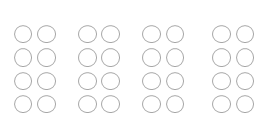
Question 9.
__ + __ + __ = 3 × 7
Answer:
3 groups of 7.
7 + 7 + 7 = 21.
3 x 7 = 21.
Explanation:
In the above-given question,
given that,
there are 3 groups of 7.
that means group A contains 7.
group B contains 7.
group C contains 7.
addition equation is 7 + 7 + 7 = 21.
multiplication equation is 3 x 7 = 21.

Question 10.
9 + __ + __ = 3 × ___
Answer:
3 groups of 9.
9 + 9 + 9 = 27.
3 x 9 = 27.
Explanation:
In the above-given question,
given that,
there are 3 groups of 9.
that means group A contains 9.
group B contains 9.
group C contains 9.
addition equation is 9 + 9 + 9 = 27.
multiplication equation is 3 x 9 = 27.

Question 11.
6 + 6 + 6 + 6 + 6 = ___ × ___
Answer:
5 groups of 6.
6 + 6 + 6 + 6 + 6 = 30.
5 x 6 = 30.
Explanation:
In the above-given question,
given that,
there are 5 groups of 6.
that means group A contains 6.
group B contains 6.
group C contains 6.
group D contains 6.
group E contains 6.
addition equation is 6 + 6 + 6 + 6 + 6 = 30.
multiplication equation is 5 x 6 = 30.

Problem Solving
Question 12.
Debra draws this shape on the back of her notebook.

What is the name of the shape Debra draws? How do you know?
Answer:
The name of the shape Debra draws is a hexagon.
Explanation:
In the above-given question,
given that,
Debra shows the shape on the back of her notebook.
For example: if the shape contains 3 sides it is a triangle.
if the shape contains 4 sides it is a rhombus.
if the shape contains 5 sides it is a pentagon.
if the shape contains 6 sides it is the hexagon.
so the above-drawn figure is a hexagon.
It has 6 sides.
Question 13.
Model with Math Salvatore gets 50 trading cards for his birthday. He gives 22 cards to Madison, and Madison gives 18 cards to Salvatore. Then Salvatore’s sister gives him 14 cards. How many trading cards does Salvatore have now? Use math to represent the problem.
Answer:
The number of cards does Salvatore has = 60 cards.
Explanation:
In the above-given question,
given that,
Salvatore gets 50 trading cards for his birthday.
he gives 22 cards to madison, and madison gives 18 cards to Salvatore.
then Salvatore’s sister gives him 14 cards.
50 – 22 = 28.
28 + 18 = 46.
46 + 14 = 60.
so the number of cards does Salvatore have = 60.
Question 14.
Higher Order Thinking Luke says you can always add and you can always multiply to join groups. Is he correct? Explain why or why not.
Answer:
Yes, Luke was correct.
Explanation:
In the above-given question,
given that,
Luke says you can always add and you can always multiply to join groups.
for example:
2 groups of 5.
5 + 5 = 10.
2 x 5 = 10.
so luke was correct.
Question 15.
Lois says any addition equation where the addends are all the same can be written as a multiplication equation. Is Lois correct? Explain why or why not.
Answer:
Yes, Lois was correct.
Explanation:
In the above-given question,
given that,
Lois says any addition equation where the addends are all the same can be written as a multiplication equation.
for example 3 groups of 4.
4 + 4 + 4 = 12.
3 x 4 = 12.
so Lois was correct.
Assessment Practice
Question 16.
Tom has 12 ears of field corn to make table decorations. He arranges them in equal groups. Which sentences could Tom use to describe his groups? Select all that are correct.
![]() Tom arranged 2 groups of 4 ears.
Tom arranged 2 groups of 4 ears.
![]() Tom arranged 4 groups of 2 ears.
Tom arranged 4 groups of 2 ears.
![]() Tom arranged 6 groups of 2 ears.
Tom arranged 6 groups of 2 ears.
![]() Tom arranged 3 groups of 4 ears.
Tom arranged 3 groups of 4 ears.
![]() Tom arranged 1 group of 10 ears.
Tom arranged 1 group of 10 ears.
Answer:
Tom arranged 6 groups of 2 ears.
he arranged 3 groups of 4 ears.
Explanation:
In the above-given question,
given that,
Tom has 12 years of field corn to make table decorations.
He arranges them in equal groups.
Addition equation:
6 groups of 2 ears.
2 + 2 + 2 + 2 + 2 + 2 = 12.
multiplication equation:
6 x 2 = 12.
3 groups of 4 ears.
4 + 4 + 4 = 12.
3 x 4 = 12.
Question 17.
Jenna has 24 flowers. She arranges them in vases with an equal number of flowers in each vase. Which sentences could Jenna use to describe her flowers? Select all that are correct.
![]() Jenna arranged 4 flowers in each of 6 vases.
Jenna arranged 4 flowers in each of 6 vases.
![]() Jenna arranged 3 flowers in each of 9 vases.
Jenna arranged 3 flowers in each of 9 vases.
![]() Jenna arranged 5 flowers in each of 5 vases.
Jenna arranged 5 flowers in each of 5 vases.
![]() Jenna arranged 6 flowers in each of 3 vases.
Jenna arranged 6 flowers in each of 3 vases.
![]() Jenna arranged 8 flowers in each of 3 vases.
Jenna arranged 8 flowers in each of 3 vases.
Answer:
Jenna arranged 4 flowers in each of 6 vases.
she also arranged 8 flowers in each of the 3 vases.
Explanation:
In the above-given question,
given that,
Jenna has 24 flowers.
she arranges them in vases with an equal number of flowers in each vase.
Jenna arranged 4 flowers in each of 6 vases.
4 flowers of 6 vases.
6 + 6 + 6 + 6 = 24.
4 x 6 = 24.
she also arranged 8 flowers in each of 3 vases.
8 flowers of 3 vases.
3 + 3 + 3 + 3 + 3 + 3 + 3 + 3 = 24.
8 x 3 = 24.
Lesson 1.2 Multiplication on the Number Line
Activity
Solve & Share
Harvey the Hop Toad starts at 0 and jumps 7 times in the same direction. Each time he jumps 3 inches farther. How can you show how far Harvey goes on a number line?

Look Back!
How are Harvey’s jumps on the number line like repeated addition? How are they like skip counting?
Answer:
Harvey’s jumps on the number line are like skip counting.
Explanation:
In the above-given question,
given that,
Harvey the Hop Toad starts at 0 and jumps 7 times in the same direction.
Each time he jumps 3 inches farther.
0 + 3 = 3.
3 + 3 = 6.
6 + 3 = 9.
9 + 3 = 12.
12 + 3 = 15.
15 + 3 = 18.
18 + 3 = 21.
7 x 3 = 21.

Essential Question
How Can You Use a Number Line to Show Multiplication?
Answer:
7 x 3 = 12.
Explanation:
In the above-given question,
given that,
Harvey the Hop Toad starts at 0 and jumps 7 times in the same direction.
Each time he jumps 3 inches farther.
0 + 3 = 3.
3 + 3 = 6.
6 + 3 = 9.
9 + 3 = 12.
12 + 3 = 15.
15 + 3 = 18.
18 + 3 = 21.
7 x 3 = 21.
Visual Learning Bridge
Clara is making gift bags for her 5 friends. She wants to put 3 glitter pens in each gift bag. How many glitter pens does Clara need?


Convince Me!
Reasoning What would skip counting by 6 look like on the number line?
Answer:
6 look like 6 pens on the number line.
Explanation:
In the above-given question,
given that,
Clara is making gift bags for her 5 friends.
She wants to put 3 glitter pens in each gift bag.
0 + 3 = 3 pens.
3 + 3 = 6 pens.
6 + 3 = 9 pens.
9 + 3 = 12 pens.
12 + 3 = 15 pens.
so 6 on the number line looks like 6 pens.
Guided Practice
Do You Understand?
Question 1.
On the previous page, why do you skip count by 3s on the number line?
Answer:
They skip count by 3s on the number line represents 3 pens.
Explanation:
In the above-given question,
given that,
Clara is making gift bags for her 5 friends.
She wants to put 3 glitter pens in each gift bag.
0 + 3 = 3 pens.
the skip count by 3s on the number line represents 3 pens.
Question 2.
On the previous page, why do you make five jumps on the number line?
Answer:
Clara is making gift bags for her 5 friends.
Explanation:
In the above-given question,
given that,
Clara is making gift bags for her 5 friends.
She wants to put 3 glitter pens in each gift bag.
0 + 3 = 3 pens.
3 + 3 = 6 pens.
6 + 3 = 9 pens.
9 + 3 = 12 pens.
12 + 3 = 15 pens.
so Clara wants to make gift bags for her 5 friends.
Question 3.
How would the jumps on the number line look different if there were 4 pens in each gift bag?
Answer:
Yes, the number line looks different if there were 4 pens in each gift bag.
Explanation:
In the above-given question,
given that,
Clara is making gift bags for her 5 friends.
She wants to put 4 glitter pens in each gift bag.
0 + 4 = 4 pens.
4 + 4 = 8 pens.
8 + 4 = 12 pens.
12 + 4 = 16 pens.
Do You Know How?
In 4, complete the arrows on the number line to show the jumps and fill in the blanks.
Question 4.
Jim ran 3 miles a day for 4 days in a row. How many miles did he run?

Number of jumps: ___
I skip counted by ___.
Jim ran ___ miles.
___ × ___ = ___
Answer:
The number of jumps = 12.
I skip counted by 3.
Jim ran 12 miles.
3 x 4 = 12.
Explanation:
In the above-given question,
given that,
Jim ran 3 miles a day for 4 days in a row.
in one day he ran 3 miles.
in 2 days = 6 miles.
3 days = 9 miles.
4 days = 12 miles.

Independent Practice
In 5, show how you found the solution using the number line.
Question 5.
Judy has 6 fruit baskets. She wants to put 2 apples into each basket. How many apples will she need? Draw the remaining jumps on the number line with arrows to show how many apples Judy will need.

Judy will need __ apples.
Answer:
The number of apples Judy will need = 12.
Explanation:
In the above-given question,
given that,
Judy has 6 fruit baskets.
she wants to put 2 apples into each basket.
0 + 2 = 2.
2 + 2 = 4.
4 + 2 = 6.
6 + 2 = 8.
8 + 2 = 10.
10 + 2 = 12.
6 x 2 = 12.
so the number of apples Judy needs = 12.

in 6 and 7, show the multiplication fact with arrows on the number line. Write the product.
Question 6.
7 × 2 = ___

Answer:
7 x 2 = 14.
Explanation:
In the above-given figure,
given that,
there are 15 numbers on the number line.
7 x 2 = 14.
0 + 2 = 2 in 1st jump.
2 + 2 = 4 in 2nd jump.
4 + 2 = 6 in 3rd jump.
6 + 2 = 8 in 4th jump.
8 + 2 = 10 in 5th jump.
10 + 2 = 12 in 6th jump.
12 + 2 = 14 in 7th jump.
7 x 2 = 14.

Question 7.
3 × 3 = ___

Answer:
3 x 3 = 9.
Explanation:
In the above-given figure,
given that,
there are 15 numbers on the number line.
0 + 3 = 3 in 1st jump.
3 + 3 = 6 in 2nd jump.
6 + 3 = 9 in 3rd jump.
so 3 x 3 = 9.

Problem Solving
Question 8.
Nikki wants to use 3 glass beads in each necklace she is making. She wants to make 6 necklaces. How many glass beads will Nikki need? Use skip counting and write a multiplication equation to solve.

Answer:
The number of glass beads will Nikki need = 18.
Explanation:
In the above-given figure,
given that,
Nikki wants to use 3 glass beads in each necklace she is making.
she wants to make 6 necklaces.
0 + 3 = 3.
3 + 3 = 6.
6 + 3 = 9.
9 + 3 = 12.
12 + 3 = 15.
15 + 3 = 18.
3 x 6 = 18.
so the number of glass beads will Nikki need = 18 beads.
Question 9.
enVision® STEM Guinea pigs in the wild usually live in groups of between 5 and 10. The group members can warn each other of danger. If there are 2 groups of 7 guinea pigs, how many guinea pigs are there in all? Use the number line to solve.

Answer:
The number of guinea pigs in all = 14.
Explanation:
In the above-given question,
given that,
Guinea pigs in the wild usually live in groups of between 5 and 10.
The group members can warn each other of danger.
if there are 2 groups of 7 guinea pigs.
0 + 7 = 7.
7 + 7 = 14.
2 x 7 = 14.
so the number of guinea pigs in all = 14.

Question 10.
Make Sense and Persevere Tim drew this number line to show the multiplication fact 4 × 2 = 8.

Which parts of the number line represent the factors? Which part shows the product?
Answer:
The number line represents the factors are 4, 2, 6, and 8.
the number line that represents the products is 8.
Explanation:
In the above-given question,
given that,
Tim draws this number line to show the multiplication fact 4 x 2 = 8.
so 2, 4, 6 are the factors.
4 x 2 = 8.
8 is the product.
Question 11.
Higher Order Thinking Draw a number line to compare skip counting by 3s four times and skip counting by 4s three times. How are they different? How are they alike?
Assessment Practice
Question 12.
Which of the following contexts do the number line and the expression 5 × 2 represent?

A. 5 groups with 5 pens in each
B. 5 groups with 2 pens in each
C. 2 groups with 2 pens in each
D. 2 groups with 5 pens in each
Answer:
Option B is correct.
Explanation:
In the above-given question,
given that,
0 + 2 = 2.
2 + 2 = 4.
4 + 2 = 6.
6 + 2 = 8.
8 + 2 = 10.
2 + 2 + 2 + 2 + 2 = 10.
5 x 2 = 10.
so 5 groups with 2 pens in each.
Question 13.
Which of the following contexts does the number line and the expression 5 × 3 represent?

A. 5 shelves with 5 books on each
B. 3 shelves with 5 books on each
C. 5 shelves with 3 books on each
D. 3 shelves with 3 books on each
Answer:
Option c is correct.
Explanation:
In the above-given question,
given that,
5 x 3 = 15.
5 shelves with 3 books on each.
0 + 3 = 3.
3 + 3 = 6.
6 + 3 = 9.
9 + 3 = 12.
12 + 3 = 15.
3 + 3 + 3 + 3 + 3 = 15.
5 x 3 = 15.
Lesson 1.3 Arrays and Properties
Activity
Solve & Share
Mark has 12 sports cards. He arranges the cards with an equal number in each row. Find ways Mark can arrange his cards.

Look Back! What do you notice about the number of rows of cards, the number of cards in each row, and the total number of cards? Explain.
Answer:
2 x 6 = 12.
4 x 3 = 12.
6 x 2 = 12.
3 x 4 = 12.
1 x 12 = 12.
12 x 1 = 12.
Explanation:
In the above-given question,
given that,
Mark has 12 spot cards.
2 x 6 = 12.
4 x 3 = 12.
6 x 2 = 12.
3 x 4 = 12.
1 x 12 = 12.
12 x 1 = 12.

Visual Learning Bridge
Essential Question
How Does an Array Show Multiplication?
A.
Dana keeps her swimming medal collection in a display on the wall.
The display has 4 rows. Each row has 5 medals. How many medals are in Dana’s collection?
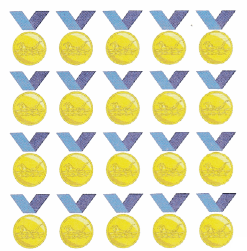

B.
The counters show 4 rows and 5 columns.

C.
Multiplication can also be used to find the total in an array.
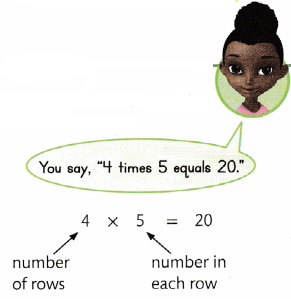
There are 20 medals in Dana’s collection.
Convince Me!
Construct Arguments Jason also has a swimming medal collection. His display has 5 rows with 5 medals in each row. Draw an array for Jason’s medals. Use skip counting to find the total number of medals. Then write a multiplication equation for your array. Who has more medals, Jason or Dana?
Answer:
Jason has more medals.
Explanation:
In the above-given question,
given that,
Jason also has a swimming medal collection.
His display has 5 rows with 5 medals in each row.
5 x 5 = 25.
Dana has only 20 medals.
Jason has more medals.

Another Example!
Dana rearranged her swimming medal collection. The arrays have the same number of medals.


Guided Practice
Do You Understand?
Question 1.
Mia puts muffins in 4 rows with 7 muffins in each row. Draw an array to find the total number of muffins.
Answer:
The total number of muffins = 28 muffins.
Explanation:
In the above-given question,
given that,
Mia puts muffins in 4 rows with 7 muffins in each row.
There are 4 rows.
In each row, there are 7 muffins.
4 x 7 = 28.
7 x 4 = 28.
so the total number of muffins = 28 muffins.

Question 2.
Complete the following statement.
4 × 7 = 28, so 7 × 4 = ___.
Answer:
7 x 4 = 28.
Explanation:
In the above-given question,
given that,
4 x 7 = 28.
7 x 4 = 28.
Do You Know How?
In 3, write and solve a multiplication equation for the array.
Question 3.
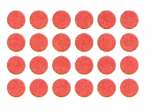
Answer:
4 x 6 = 24.
Explanation:
In the above-given question,
given that,
The multiplication for the given array.
there are 4 rows.
in each row, there are 6.
4 x 6 = 24.
Independent Practice
In 4 and 5, fill in the blanks to show skip counting and multiplication for each array.
Question 4.

Answer:
2, 4, 6, 8.
4 x 2 = 8.
4, 8.
2 x 4 = 8.
Explanation:
In the above-given question,
given that,
2 + 2 = 4.
4 + 2 = 6.
6 + 2 = 8.
2 x 4 = 8.
4 x 2 = 8.
Question 5.

Answer:
3, 6, 9, and 12.
4 x 3 = 12.
4, 8, and 12.
3 x 4 = 12.
Explanation:
In the above-given question,
given that,
3 + 3 = 6.
3 + 6 = 9.
9 + 3 = 12.
4 x 3 = 12.
3 x 4 = 12.

Problem Solving
Question 6.
Liza draws these two arrays. How are the arrays alike? How are they different?

Answer:
5 x 3 = 15.
3 x 5 = 15.
Explanation:
In the above-given question,
given that,
they are the same when the total number of arrays is 15.
they are different when the number of rows and number of columns is not equal.
for example 5 x 3 = 15.
2 x 3 = 6.
Question 7.
Use Structure Chen arranged 16 berries in the array shown below. Use counters to help complete the table to show other arrays Chen can make with the same number of berries.
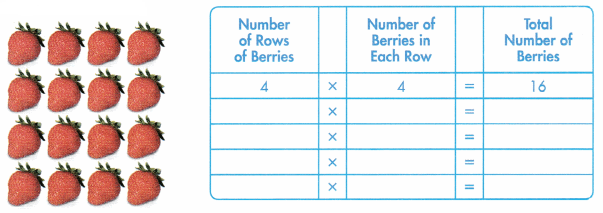
Answer:
8 x 2 = 16.
2 x 8 = 16.
1 x 16 = 16.
16 x 1 = 16.
Explanation:
In the above-given question,
given that,
the number of rows of berries = 4.
the number of columns of berries = 4.
the total number of berries = 16.
2 x 8 = 16.
8 x 2 = 16.
1 x 16 = 16.
16 x 1 = 16.

Question 8.
Higher Order Thinking Ramón says he can use the Commutative Property of Multiplication to show the product of 4 × 6 is the same as the product of 3 × 8. Is he correct? Why or why not?
Answer:
No, he was not correct.
Explanation:
In the above-given question,
given that,
Ramon says he can use the commutative property of multiplication to show the product of 4 x 6 is not as same as 3 x 8.
In commutative property we can write 4 x 6 = 24.
6 x 4 = 24.
so Ramon was not correct.
Question 9.
Delbert put 5 nickels in each of his 3 empty piggy banks. How many nickels did Delbert put in the banks? Write a multiplication equation to show how you solved the problem.

Answer:
The number of nickels did Delbert put in the banks = 15.
Explanation:
In the above-given question,
given that,
Delbert put 5 nickels in each of his 3 empty piggy banks.
multiplication equation is 3 x 5 = 15.
so the number of nickels did Delbert put in the banks = 15.
Assessment Practice
Question 10.
An equation is shown.
8 × 5 = 5 × ![]()
Use the Commutative Property of Multiplication to find the missing factor.
A. 5
B. 8
C. 40
D. 85
Answer:
Option B is correct.
Explanation:
In the above-given question,
given that,
8 x 5 = 40.
5 x 8 = 40.
so option B is correct.
Question 11.
Using the Commutative Property of Multiplication, which of the following expressions is equivalent to 5 × 4?
A. 5 + 5
B. 4 × 5
C. 5 + 4
D. 5 – 4
Answer:
5 x 4 = 4 x 5.
Explanation:
In the above-given question,
given that,
commutative property of multiplication of expression 5 x 4 = 20.
4 x 5 = 20.
so 5 x 4 = 4 x 5.
Lesson 1.4 Division: How Many in Each Group?
Activity
Solve & Share
Six friends picked 48 grapefruits. They want to share them equally. How many grapefruits should each friend get?


Look Back!
How can you use counters to help solve this problem? Explain.
Answer:
6 x 8 = 48.
Explanation:
In the above-given question,
given that,
Six friends picked 48 grapefruits.
They want to share them equally.
6 x 8 = 48.
Visual Learning Bridge
Essential Question
How Many are in Each Group?
A.
Three friends have 12 toys to share equally. How many toys will each friend get?
Think of arranging 12 toys into 3 equal groups.

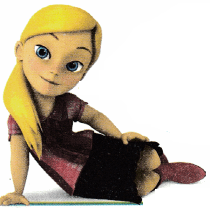
Division is an operation that is used to find how many equal groups there are or how many are in
each group.
B. What You Think
Put one toy at a time in each group.

When all the toys are grouped, there will be 4 in each group.
C. What You Write You can write a division equation to find the number in each group.

Each friend will get 4 toys.
Convince Me!
Be Precise What would happen if 3 friends wanted to share 13 toys equally?
Answer:
13 / 3 = 4.3
Explanation:
In the above-given question,
given that,
if 3 friends wanted to share 13 toys each.
13 / 3 = 4.3.
nearly 4 toys will share 3 friends.
Guided Practice
Do You Understand?
Question 1.
Eighteen eggs are divided into 3 rows. How many eggs are in each row? Use the bar diagram to solve.
Answer:
The number of eggs in each row = 6.
Explanation:
In the above-given question,
given that,
18 eggs are divided into 3 rows.
18 / 3 = 6.
so the number of eggs in each row = 6.
Question 2.
Can 12 grapes be shared equally among 5 children with no grapes remaining? . Explain.
Answer:
No.
Explanation:
In the above-given question,
given that,
12 grapes are shared equally among 5 children.
12 / 5 = 2.4.
2 grapes are remaining.
so 12 grapes cannot be shared equally among 5 children.
Do You Know How?
In 3 and 4, draw a picture to solve.
Question 3.
Fifteen bananas are shared equally by 3 monkeys. How many bananas does each monkey get?
Answer:
The number of bananas does each monkey gets =
Explanation:
In the above-given question,
given that,
Fifteen bananas are shared equally by 3 monkeys.
15 / 3 = 5.
so the number of bananas does each monkey gets = 5.

Question 4.
Sixteen plants are divided equally into 4 pots. How many plants are in each pot?
Answer:
The number of plants in each pot = 4.
Explanation:
In the above-given question,
given that,
sixteen plants are divided equally into 4 pots.
16 / 4 = 4.
so the number of plants in each pot = 4.
Independent Practice
In 5 and 6, draw a picture to solve.
Question 5.
Eighteen marbles are divided equally into 6 sacks. How many marbles are in each sack?
Answer:
The number of marbles is in each sack = 3.
Explanation:
In the above-given question,
given that,
Eighteen marbles are divided equally into 6 sacks.
18 / 6 = 3.
so the number of marbles in each sack = 3.

Question 6.
Sixteen crayons are shared equally by 2 people. How many crayons does each person have?
Answer:
The number of crayons does each person has = 8.
Explanation:
In the above-given question,
given that,
sixteen crayons are shared equally by 2 people.
16 / 2 = 8.
so the number of crayons does each person has = 8.

In 7-10, complete each equation.
Question 7.
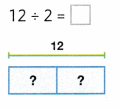
Answer:
12 / 2 = 6.
Explanation:
In the above-given question,
given that,
12 / 2 = 6.
6 x 2 = 12.

Question 8.

Answer:
16 / 8 = 2.
Explanation:
In the above-given question,
given that,
16 / 8 = 2.
2 x 8 = 16.

Question 9.
9 ÷ 3 = ___
Answer:
9 / 3 = 3.
Explanation:
In the above-given question,
given that,
9 / 3 = 3.
3 x 3 = 9.
Question 10.
14 ÷ 7 = __
Answer:
14 / 7 = 2.
Explanation:
In the above-given question,
given that,
14 / 7 = 2.
7 x 2 = 14.
Problem Solving
Question 11.
Jim is putting 18 pens into equal groups. He says if he puts them into 2 equal groups he will have more pens in each group than if he puts them into 3 equal groups. Is Jim correct? Explain.
Answer:
Yes, Jim was correct.
Explanation:
In the above-given question,
given that,
Jim is putting 18 pens into equal groups.
He says if he puts them into 2 equal groups he will have more pens.
if he puts them into 3 equal groups.
6 + 6 + 6 = 18.
3 x 6 = 18.
so Jim was correct.
Question 12.
Make Sense and Persevere Ms. Terry’s class is hosting a fundraising challenge. The students in her class are divided into 4 teams. Each team has an equal number of students. Do you have enough information to find how many students are on each team? Explain.
Answer:
The number of students is on each team = 16.
Explanation:
In the above-given question,
given that,
Ms. Terry’s class is hosting a fundraising challenge.
The students in her class are divided into 4 teams.
Each team has an equal number of students.
4 + 4 + 4 + 4 = 16.
4 x 4 = 16.
16 / 4 = 4.
so the number of students are on each team = 16.
Question 13.
Erika draws a hexagon. Maria draws a pentagon. Who draws the shape with more sides? How many more sides does that shape have?
Answer:
Erika draws more sides.
Explanation:
In the above-given question,
given that,
Erika draws a hexagon.
Maria draws a pentagon.
hexagon has one more side than the pentagon.
Pentagon has 5 sides.
hexagon has 6 sides.
Question 14.
The flag bearers in a parade march in 9 rows with 5 flags in each row. Write an equation to show how many flags there are.
Answer:
The number of flags is there = 45.
Explanation:
In the above-given question,
given that,
the flag bearers in a parade march in 9 rows with 5 flags in each row.
9 x 5 = 45.
45 / 5 = 9.
45 / 9 = 5.
so the number of flags are there = 45.
Question 15.
Number Sense Jenn and some friends share 40 jellybeans equally. Is the number that each friend gets greater than 40 or less than 40? Explain.
Answer:
Each friend gets less than 40.
Explanation:
In the above-given question,
given that,
Jenn and some friends share 40 jellybeans equally.
8 x 5 = 40.
so 8 friends share 5 jellybeans each.
so each friend gets less than 40.
Question 16.
Higher Order Thinking Joy has 12 shells. She gives 2 shells to her mom. Then she and her sister share the rest of the shells equally. How many shells does Joy get? How many shells does her sister get? How do you know?
Answer:
The number of shells Joy gets = 5.
the number of shells her sister gets = 5.
Explanation:
In the above-given question,
given that,
Joy has 12 shells.
She gives 2 shells to her mom.
Then she and her sister share the rest of the shells equally.
12 – 2 = 10.
5 + 5 = 10.
so the number of shells Joy get = 5.
the number of shells her sister get = 5.
Assessment Practice
Question 17.
Which of the following contexts does the expression 14 ÷ 2 represent? @ 14 pens arranged in
A. 14 pens arranged in 14 equal groups
B. 2 pens arranged in 14 equal groups
C. 14 pens arranged in 2 equal groups
D. 2 pens arranged in 2 equal groups
Answer:
Option B is correct.
Explanation:
In the above-given question,
given that,
the expression 14/2 represents
2 pens arranged in 14 equal groups.
so option B is correct.
Question 18.
Which of the following contexts does the expression 12 ÷ 3 represent?
A. 12 books arranged equally on 3 shelves
B. 12 books arranged equally on 12 shelves
C. 3 books arranged equally on 12 shelves
D. 3 books arranged equally on 3 shelves
Answer:
Option C is correct.
Explanation:
In the above-given question,
given that,
the expression 12 / 3 represents,
3 books arranged on 12 shelves.
so option C is correct.
Lesson 1.5 Division: How Many Equal Groups?
Activity
Solve & Share
Li made 12 tacos. He wants to give some of his friends 2 tacos each. If Li does not get any of the tacos, how many of his friends will get tacos?

You can use reasoning. How can what you know about sharing help you solve the problem?
Answer:
The number of friends gets 2 tacos each = 6.
Explanation:
In the above-given question,
given that,
I made 12 tacos. He wants to give some of his friends 2 tacos each.
12 / 2 = 6.
so the number of friends gets 2 tacos each = 6.
Look Back!
How can counters or other objects help you show your work?
Visual Learning Bridge
Essential Question
How Can You Divide Using Repeated Subtraction?
A.
June has 10 strawberries to serve to her guests. If each guest eats 2 strawberries, how many guests can June serve?

B. You can use repeated subtraction to find how many groups of 2 are in 10.
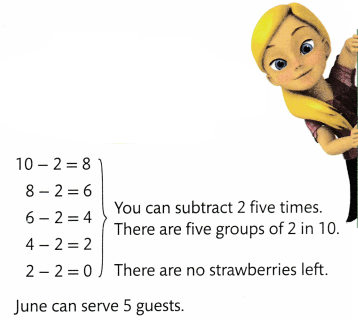
C.

You can write a division equation to find the number of groups.
Write: 10 ÷ 2 = ?
Read: Ten divided by 2 equals what number?
Solve: 10 ÷ 2 = 5
June can serve 5 guests.
Convince Me!
Model with Math In the example above, what if each guest ate 5 strawberries? Use math you know to represent the problem and find how many guests June could serve.
Answer:
June could serve 2 guests.
Explanation:
In the above-given question,
given that,
if each guest ate 5 strawberries,
10 / 5 = 2.
10 – 5 = 5.
5 – 5 = 0.
so June could serve 2 guests.

Guided Practice
Do You Understand?
Question 1.
There are 3 boxes with 2 toys in each box. The total number of toys can be expressed as 3 × 2 = 6. What is meant by 6 ÷ 3 = 2? What is meant by 6 ÷ 2 = 3?
Answer:
6 / 3 means there is the total number of toys by the total number of boxes.
6 / 2 means there is the total number of boxes by the total number of toys.
Explanation:
In the above-given question,
given that,
There are 3 boxes with 2 toys in each box.
the total number of toys can be expressed as 3 x 2 = 6.
so the total number of toys by the total number of boxes is 6 / 3.
so the total number of boxes by the total number of toys = 6 / 2.
Do You Know How?
In 2 and 3, use counters or draw a picture to solve.
Question 2.
The lost and found box has 16 gloves. There are 2 gloves in each pair. How many pairs of gloves are there?
Answer:
The number of pairs of gloves is there = 8 gloves.
Explanation:
In the above-given question,
given that,
The lost and found box has 16 gloves.
There are 2 gloves in each pair.
16 / 2 = 8.
16 – 8 = 8.
8 – 8 = 0.
so the number of pairs of gloves are there = 8.

Question 3.
Ruth gives her dogs 15 treats. Each dog gets 3 treats. How many dogs does Ruth have?
Answer:
The number of dogs does Ruth has = 5 dogs.
Explanation:
In the above-given question,
given that,
Ruth gives her dogs 15 treats.
Each dog gets 3 treats.
15 / 3 = 5.
15 – 5 = 10.
10 – 5 = 5.
5 – 5 = 0.
so the number of dogs does Ruth have = 5 dogs.

Independent Practice
Leveled Practice In 4 and 5, complete the equations.
Question 4.
Rosa picks 14 apples. She places 7 apples in each bag. How many bags does Rosa have?
14 – 7 = ___
__ – 7 = __
___ ÷ 7 = __
Rosa has ___ bags.
Answer:
The number of bags Rosa has = 2 bags.
Explanation:
In the above-given question,
given that,
Rosa picks 14 apples.
She places 7 apples in each bag.
14 – 7 = 7.
7 – 7 = 0.
14 / 7 = 2.
so the number of bags Rosa have = 2 bags.
Question 5.
The wagons on the farm have 4 wheels each. There are 12 wheels. How many wagons are on the farm?
12 – 4 = ___
__ – 4 = ___
__ – ___ = ___
There are ___ wagons.
Answer:
The number of wagons is on the farm = 3 wagons.
Explanation:
In the above-given question,
given that,
The wagons on the farm have 4 wheels each.
There are 12 wheels.
12 / 4 = 3.
12 – 4 = 8.
8 – 4 = 4.
4 – 4 = 0.
so the number of wagons are on the farm = 3 wagons.
In 6 and 7, use counters or draw a picture to solve.
Question 6.
Maria bought 30 markers that came in packages of 5 markers each. How many packages did Maria buy?
Answer:
The number of packages did Maria buy = 6.
Explanation:
In the above-given question,
given that,
Maria bought 30 markers that came in packages of 5 markers each.
30 / 5 = 6.
30 – 5 = 25.
25 – 5 = 20.
20 – 5 = 15.
15 – 5 = 10.
10 – 5 = 5.
5 – 5 = 0.
so the number of packages did Maria buy = 6.

Question 7.
Marcus has 18 pencils. He places 2 pencils on each desk. How many desks are there?
Answer:
The number of desks is there = 9.
Explanation:
In the above-given question,
given that,
Marcus has 18 pencils.
He places 2 pencils on each desk.
18 / 2 = 9.
18 – 9 = 9.
9 – 9 = 0.
so the number of desks are there = 9.

Problem Solving
Question 8.
Generalize The chart shows the number of pennies each of three friends has in her pocket. Each friend divides her money into groups of 3 coins. Write division equations to show how many equal groups each friend can make. Explain what repeats in the equations.

Answer:
18 / 3 = 6.
12 / 3 = 4.
15 / 3 = 5.
Explanation:
In the above-given question,
given that,
The chart shows the number of pennies each of the three friends has in her pocket.
Claudia has 18 cents in her pocket.
18 / 3 = 6.
Zoe has 12 cents in her pocket.
12 / 3 = 4.
Jenna has 15 cents in her pocket.
15 / 3 = 5.
Question 9.
If Zoe has 6 pennies in each row, how many rows does she make?
Answer:
The number of rows does she make = 2.
Explanation:
In the above-given question,
given that,
If Zoe has 6 pennies in each row.
12 / 6 = 2.
12 – 6 = 6.
6 – 6 = 0.
so the number of rows does she make = 2.
Question 10.
Bella has $52. She spends $21, and then finds $12. How much money does she have now? Use equations to represent the problem.
Answer:
The money does she have now = $43.
Explanation:
In the above-given question,
given that,
Bella has $52.
she spends $21 and then finds $12.
$52 – $21 = $31.
$31 + $12 = $43.
so the money does she have now = $43.
Question 11.
Higher Order Thinking An ice cream store plans to make 8 new flavors each year. How many years will it take for the store to make 80 flavors? Write and solve an equation.
Answer:
The number of years will it take for the store to make 80 flavors = 10 years.
Explanation:
In the above-given question,
given that,
An ice cream store plans to make 8 new flavors each year.
80 / 8 = 10.
80 – 8 = 72.
72 – 8 = 64.
64 – 8 = 56.
56 – 8 = 48.
48 – 8 = 40.
40 – 8 = 32.
32 – 8 = 24.
24 – 8 = 16.
16 – 8 = 8.
8 – 8 = 0.
so the number of years will it take for the store to make 80 flavors = 10 years.
Assessment Practice
Question 12.
Eric writes 20 ÷ 5. Which problem could Eric’s expression represent?
A. There are 20 apples. Each guest gets 10 apples. How many guests are there?
B. There are 20 pencils. Each student gets 2 pencils. How many students are there?
C. There are 5 pens. Each student gets 1 pen. How many students are there?
D. There are $20. Each child gets $5. How many children are there?
Answer:
Option D is correct.
Explanation:
In the above-given question,
given that,
there are $20.
each child gets $5.
20 / 5 = 4.
so option D is correct.
Question 13.
Jacqui writes 24 ÷ 8. Which problem could Jacqui’s expression represent?
A. There are 24 bows. Each child gets 8 bows. How many children are there?
B. There are 24 chicks. Each box holds 2 chicks. How many boxes are there?
C. There are 24 horses. Each arena has 12 horses. How many arenas are there?
D. There are 24 coins. Each pile has 24 coins. How many piles are there?
Answer:
Option A is correct.
Explanation:
In the above-given question,
given that,
Jacqui writes 24 /8 = 4.
there are 24 bows.
Each child gets 8 bows.
24 – 8 = 16.
16 – 8 = 8.
8 – 8 = 0.
so option A is correct.
Lesson 1.6 Use Appropriate Tools
Problem Solving
Activity
Solve & Share
Carolyn earned $8 a week for 2 weeks. She wants to buy some books that cost $4 each. How many books can she buy?
Choose a tool to represent and solve the problem. Explain why you chose that tool.
Answer:
The number of books she can buy = 4 books.
Explanation:
In the above-given question,
given that,
Carolyn earned $8 a week for 2 weeks.
She wants to buy some books that cost $4 each.
$ 8 + $ 8 = $ 16.
$ 16 / $ 4 = $ 4.
so the number of books she can buy = $ 4.
Thinking Habits
Be a good thinker!
These questions can help you.
∙ Which tools can I use?
∙ Why should I use this tool to help me solve the problem?
∙ Is there a different tool I could use?
∙ Am I using the tool appropriately?

Look Back!
Use Appropriate Tools Explain how you used the tool you chose.
Visual Learning Bridge
Essential Question
How Can You Use Appropriate Tools to Represent and Solve Problems?
A.
A hardware store has boxes of 18 light bulbs. 3 light bulbs cost $4. How much does it cost to buy a whole box of light bulbs? Choose a tool to represent and solve the problem.
Sometimes you can use more than one tool to help you solve problems.

What do I need to do?
I need to choose an appropriate tool to help me find how much it costs to buy a box of 18 light bulbs.
B. Which tools can I use to help me solve this problem?
I can
- decide which tools are appropriate.
- use cubes and counters to solve this problem.
- use the tools correctly.
C.
Here’s my thinking…

I will use two tools. Both counters and ones cubes are easy to count and move around.
Each cube is 1 light bulb. I will separate 18 cubes into groups of 3.
Each counter is $1. I will put 4 counters with each group of 3 light bulbs.
There are 24 counters. A box of light bulbs costs $24.

Convince Me!
Use Appropriate Tools What other tools could you use to help solve this problem?
Guided Practice
Use Appropriate Tools
Three friends each have 8 books. They put their books into 4 equal piles. How many books are in each pile?

You can also use appropriate digital tools. Technology can help you solve a problem.
Answer:
The number of books in each pile = 6.
Explanation:
In the above-given question,
given that,
three friends each have 8 books.
they put their books into 4 equal piles.
each cube is 1 book.
I will separate 4 books into groups of 8.
8 / 4 = 2.
2 x 3 = 6.
so the number of books in each pile = 6.
Question 1.
Choose a tool to represent the problem. Explain why you chose that tool.
Answer:
I use cubes to represent the problem.
Explanation:
In the above-given question,
given that,
three friends each have 8 books.
they put their books into 4 equal piles.
each cube is 1 book.
I will separate 4 books into groups of 8.
8 / 4 = 2.
2 x 3 = 6.
so the number of books in each pile = 6.
Question 2.
Solve the problem. Explain how you used the tool you chose.
Answer:
The number of books in each pile = 6.
Explanation:
In the above-given question,
given that,
three friends each have 8 books.
they put their books into 4 equal piles.
each cube is 1 book.
I will separate 4 books into groups of 8.
8 / 4 = 2.
2 x 3 = 6.
so the number of books in each pile = 6.
Independent Practice
Use Appropriate Tools
Fifteen students are working in equal groups to make posters. There are 5 students in each group. For each group of students, there needs to be 2 adults helping. How many adults are needed?
Question 3.
Choose a tool to represent the problem. Explain why you chose that tool.
Answer:
I used cubes to solve the problem.
Explanation:
In the above-given question,
given that,
for 1 cube I am representing 5 students.
15 / 5 = 3.
3 x 2 = 6.
cubes are easy to solve the problem.
so I used cubes to solve.
Question 4.
Solve the problem. Explain how you used the tool you chose.
Answer:
The number of adults is needed = 6.
Explanation:
In the above-given question,
given that,
Fifteen students are working in equal groups to make posters. There are 5 students in each group. For each group of students, there needs to be 2 adults helping.
15 / 5 = 3.
3 x 2 = 6.
so the number of adults are needed = 6.
Question 5.
The posters need to be 20 inches long. What tool could the students use to check that the posters are the correct size? Explain how they could use this tool.
Answer:
Problem Solving
Performance Task
Bottle Cap Display
The soda bottle caps at the right are shared equally between Kerry and Nita. There are 4 orange bottle caps. Kerry wants to arrange her bottle caps into an array.

Answer:
The bottle caps into an array is 4 x 3 = 12.
Explanation:
In the above-given question,
given that,
The soda bottle caps at the right are shared equally between Kerry and Nita.
There are 4 orange bottle caps.
total there are 16 bottle caps.
16 – 4 = 12.
12 / 4 = 3.
so the bottle caps into an array is 4 x 3 = 12.
Question 6.
Make Sense and Persevere What do you need to find out before you make an array? Show a way to find this. You can use a tool to help.
Answer:
16 – 4 = 12.
Explanation:
In the above-given question,
given that,
The soda bottle caps at the right are shared equally between Kerry and Nita.
There are 4 orange bottle caps.
total there are 16 bottle caps.
16 – 4 = 12.
12 / 4 = 3.
so the bottle caps into an array is 4 x 3 = 12.
Question 7.
Use Appropriate Tools Choose a tool to represent Kerry’s array of soda bottle caps. Explain why you chose that tool.
Answer:
I choose a tool that is the cubes model.
Explanation:
In the above-given question,
given that,
one cube is equal to the 1 bottle cap.
The soda bottle caps at the right are shared equally between Kerry and Nita.
There are 4 orange bottle caps.
total there are 16 bottle caps.
16 – 4 = 12.
12 / 4 = 3.
so the bottle caps into an array is 4 x 3 = 12.
Question 8.
Model with Math Draw a picture to show how Kerry’s array might look. Then write a multiplication equation for the array.
Answer:

Think about what you need to do in the problem. Then use appropriate tools that can help you solve it.
Question 9.
Use Structure Write a different multiplication equation with the same two factors you used in Exercise 8. Has the product changed? Explain.
Answer:
Question 10.
Critique Reasoning Kerry says she can use a tens rod to represent the array. Do you agree? Explain.
Answer:
Topic 1 Fluency Review Activity
Find a Match
Work with a partner. Point to a clue. Read the clue.
Look below the clues to find a match. Write the clue letter in the box next to the match.
Find a match for every clue.

![]() 3 + 0
3 + 0
![]() 15 – 8
15 – 8
![]() 10 + 7
10 + 7
![]() 5 + 5
5 + 5
![]() 10 + 6
10 + 6
![]() 9 + 4
9 + 4
![]() 13 – 9
13 – 9
![]() 8 + 7
8 + 7
![]() 9 – 9
9 – 9
![]() 4 + 4
4 + 4
![]() 12 + 8
12 + 8
![]() 10 + 9
10 + 9
Answer:
3 + 0 = 3.
15 – 8 = 7.
10 + 7 = 17.
5 + 5 = 10.
10 + 6 = 16.
9 + 4 = 13.
13 – 9 = 4.
8 + 7 = 15.
9 – 9 = 0.
4 + 4 = 8.
12 + 8 = 20.
10 + 9 = 19.
Explanation:
In the above-given question,
given that,
20 = A, 7 = B, 16 = C, 4 = D, 10 = E, 15 = F, 3 = G, 17 = H, 0 = I, 19 = J, 8 = K, 13 = L.
3 + 0 = 3.
15 – 8 = 7.
10 + 7 = 17.
5 + 5 = 10.
10 + 6 = 16.
9 + 4 = 13.
13 – 9 = 4.
8 + 7 = 15.
9 – 9 = 0.
4 + 4 = 8.
12 + 8 = 20.
10 + 9 = 19.
Topic 1 Vocabulary Review
Glossary
Word List
• array
• column
• Commutative Property of Multiplication
• division
• equal groups
• equation
• factors
• multiplication
• number line
• product
• row
• unknown
Understand Vocabulary
Choose the best term from the Word List. Write it on the blank.
Question 1.
___ is an operation you can use to join
Answer:
The addition and multiplication is an operation used to join.
Explanation:
In the above-given question,
given that,
addition and multiplication is an operation we can use to join.
for example:
2 + 3 = 5.
3 x 2 = 6.
Question 2.
You solve an equation by finding the value that is ___
Answer:
We can solve an equation by finding the value that is unknown.
Explanation:
In the above-given question,
given that,
we can solve an equation by finding the value that is unknown.
for example:
there are 12 mangoes.
they have to share 3 friends equally.
so each friend will get how many mangoes?
12 / 3 = 4.
Question 3.
You can use a(n) ___ to display objects in rows and columns.
Answer:
We can use an array to display objects in rows and columns.
Explanation:
In the above-given question,
given that,
we can use an array to display objects in rows and columns.
Question 4.
A line marked in equal units and numbered in order is called : a(n) ___
Answer:
A line marked in equal units and numbered in order is called a number line.
Explanation:
In the above-given question,
given that,
A line marked in equal units and numbered in order is called a number line.
In number, line numbers are jumping in order.
for example:
In a number line, there are 8 numbers and jumping by 2.
0 + 2 = 2.
2 + 2 = 4.
4 + 2 = 6.
6 + 2 = 8.
For each of these terms, give an example and a non-example.

Answer:
5. 20 / 5 = 4, and 25 / 5 = 4.
6. 5 x 4 = 20, and 5 x 5 = 20.
7. 4 x 3 = 12, and 3 x 4 = 15.
Explanation:
In the above-given question,
given that,
give an example and non-example of division, equation, and the commutative property.
20 / 5 = 4 and 25 / 5 = 4.
5 x 4 = 20 and 5 x 5 = 25.
4 x 3 = 12 and 3 x 4 = 12.

Use Vocabulary in Writing
Question 8.
Explain how you can multiply 3 × 4. Use at least 2 terms from the Word List in your explanation.
Answer:
3 x 4 = 12.
4 x 3 = 12.
Explanation:
In the above-given question,
given that,
we can use the two terms multiplication and factors.
if we multiply we get 3 x 4 = 12.
3 and 4 are the factors.
12 is the product.
Topic 1 Reteaching
Set A
pages 5-8
How many is 3 groups of 4?

Remember that you can use addition or multiplication to join equal groups.
Complete each equation. Use counters or draw a picture to help.
Question 1.
2 + 2 + 2 = 3 × ___
Answer:
3 x 2 = 6.
Explanation:
In the above-given question,
given that,
we can use addition or multiplication to join equal groups.
3 groups of 2.
2 + 2 + 2 = 6.
3 x 2 = 6.

Question 2.
___+ ___ + ___ = 3 × 6
Answer:
3 x 6 = 18.
Explanation:
In the above-given question,
given that,
we can use addition or multiplication to join equal groups.
3 groups of 6.
6 + 6 + 6 = 18.
3 x 6 = 18.

Question 3.
8 + __ + ___= ___ × 8
Answer:
3 x 8 = 24.
Explanation:
In the above-given question,
given that,
we can use addition or multiplication to join equal groups.
3 groups of 8.
8 + 8 + 8 = 24.
3 x 8 = 24.

Set B
pages 9-12
Skip count by 4s three times.

Remember that you can show skip counting on a number line.
Use the number line to complete each multiplication equation.
Question 1.
2 × 3 = ___
![]()
Answer:
2 x 3 = 6.
Explanation:
In the above-given question,
given that,
the number of jumps = 2.
number in each jump = 3.
2 x 3 = 6.
2 + 2 + 2 = 6.

Question 2.
4 × 3 = ___

Answer:
4 x 3 = 12.
Explanation:
In the above-given question,
given that,
the number of jumps = 4.
number in each jump = 3.
4 x 3 = 12.
4 + 4 + 4 = 12.

Set C
pages 13-16
Find 4 × 6. The array shows 4 rows of 6 counters.

Each row is an equal group. You can use skip counting or multiplication to find the total.
Answer:
4 x 6 = 24.
Explanation:
In the above-given question,
given that,
the number of rows = 4.
number in each column = 6.
4 x 6 = 24.
Remember that an array shows objects in equal rows.
Show how to use skip counting and multiplication for each array.
Question 1.

Answer:
2 x 4 = 8.
Explanation:
In the above-given question,
given that,
the number of rows = 2.
number in each column = 4.
2 x 4 = 8.
2 + 2 + 2 + 2 = 8.
Question 2.

Answer:
3 x 6 = 18.
Explanation:
In the above-given question,
given that,
the number of rows = 3.
number in each column = 6.
3 x 6 = 18.
3 + 3 + 3 + 3 + 3 + 3 = 18.
pages 13-16
This array shows 3 rows of 4.
3 × 4 = 12

This array shows 4 rows of 3.
4 × 3 = 12

So, 3 × 4 = 4 × 3
Remember that the Commutative Property of Multiplication says you can multiply factors in any order and the product is the same.
Draw arrays and write the products.
Question 1.
2 × 5 = ____ 5 × 2 = ___
Answer:
2 x 5 = 10 and 5 x 2 = 10.
Explanation:
In the above-given question,
given that,
the number of rows = 2.
number in each column = 5.
2 x 5 = 10.
we can use commutative property.
5 x 2 = 10.
2 + 2 + 2 + 2 + 2 = 10.

Set D
pages 17-24
Two friends share 6 fruit snacks equally. How many fruit snacks does each friend get?
6 ÷ 2 = 3 fruit snacks
You can use repeated subtraction.
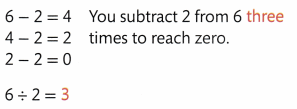
Remember that division is an operation to find the number of equal groups or the number in each equal group.
Question 1.
Nine raisin boxes are shared by 3 children. Each child gets ![]() raisin boxes.
raisin boxes.
Answer:
9 / 3 = 3.
Explanation:
In the above-given question,
given that,
Nine raisin boxes are shared by 3 children.
9 – 3 = 6.
6 – 3 = 3.
3 – 3 = 0.
9 / 3 = 3.
Question 2.
12 ÷ 2 = ___
Answer:
12 / 2 = 6.
Explanation:
In the above-given question,
given that,
12 – 2 = 10.
10 – 2 = 8.
8 – 2 = 6.
6 – 2 = 4.
4 – 2 = 2.
2 – 2 = 0.
12 / 2 = 6.
Question 3.
10 ÷ 5 = ___
Answer:
10 / 5 = 2.
Explanation:
In the above-given question,
given that,
10 – 5 = 5.
5 – 5 = 0.
10 / 5 = 2.
Question 4.
25 ÷ 5 = ___
Answer:
25 / 5 = 5.
Explanation:
In the above-given question,
given that,
25 – 5 = 20.
20 – 5 = 15.
15 – 5 = 10.
10 – 5 = 5.
5 – 5 = 0.
25 / 5 = 5.
Question 5.
16 ÷ 4 = ___
Answer:
16 / 4 = 4.
Explanation:
In the above-given question,
given that,
16 – 4 = 12.
12 – 4 = 8.
8 – 4 = 4.
4 – 4 = 0.
16 / 4 = 4.
Question 6.
12 ÷ 3 = __
Answer:
12 / 3 = 4.
Explanation:
In the above-given question,
given that,
12 – 3 = 9.
9 – 3 = 6.
6 – 3 = 3.
3 – 3 = 0.
12 / 3 = 9.
Question 7.
24 ÷ 6 = ___
Answer:
24 / 6 = 4.
Explanation:
In the above-given question,
given that,
24 – 6 = 18.
18 – 6 = 12.
12 – 6 = 6.
6 – 6 = 0.
24 / 6 = 4.
Set E
pages 25 – 28
Think about these questions to help you use appropriate tools strategically.
Thinking Habits
Which tools can I use?
Why should I use this tool to help me solve the problem?
Is there a different tool I could use?
Am I using the tool appropriately?

Remember that you can use digital tools.
Sam makes enough muffins to give 8 of her friends 3 muffins each. Each tray holds 6 muffins. How many trays does she need?
Question 1.
Choose a tool to represent the problem. Explain why you chose that tool.
Answer:
The number of trays she needs = 16 trays.
Explanation:
In the above-given question,
given that,
Sam makes enough muffins to give 8 of her friends 3 muffins each.
Each tray holds 6 muffins.
8 / 3 = 2.6.
2.6 x 6 = 15.6.
so the number of trays she needs = 16 trays.
Question 2.
Solve. Explain how the tool helped.
Answer:
Topic 1 Assessment Practice
Question 1.
Jace drew a picture. Which multiplication expression represents the total number of circles?

A. 4 × 3
B. 4 × 1
C. 4 × 2
D. 4 × 8
Answer:
Option C is correct.
Explanation:
In the above-given question,
given that,
4 groups of 2.
2 + 2 + 2 + 2 = 8.
4 x 2 = 8.
so option C is correct.
Question 2.
Aidan has 2 turtles in each of 4 aquariums.
A. Write an equation that represents how many turtles Aidan has in all.
B. How many turtles does Aidan have in all?
![]() turtles
turtles
Answer:
A. 4 x 2.
B. The number of turtles do Aidan has in all = 8.
Explanation:
In the above-given question,
given that,
Aidan has 2 turtles in each of 4 aquariums.
4 groups of 2.
2 + 2 + 2 + 2 = 8.
4 x 2 = 8.
so the number of turtles do aidan have in all = 8.
Question 3.
Noah’s watering can holds enough water for watering 4 plants. How many plants can Noah water if he fills his watering can 3 times?
![]() plants
plants
Answer:
The number of plants can Noah water if he fills his watering can 3 times = 12 plants.
Explanation:
In the above-given question,
given that,
Noah’s watering can holds enough water for watering 4 plants.
4 x 3 = 12.
that means she can water 3 plants one time.
3 + 3 + 3 = 12.
so the number of plants can Noah water = 12 plants.
Question 4.
Megan organized her photos in this array. What is the multiplication equation for the array? Draw a different array that has the same factors.

Answer:
The different array that has the same factors = 3 and 4.
Explanation:
In the above-given question,
given that,
Megan organized her photos in this array.
4 x 3.
3 + 3 + 3 + 3 = 12.
4 x 3 = 12.
we can write it as 3 x 4.
4 + 4 + 4 = 12.
3 x 4 = 12.
so the new array = 3 x 4.

Question 5.
Josiah kicked six 3-point field goals in his football game. Which multiplication equation represents the number of points that Josiah scored?
A. 6 × 3 = 18
B. 6 × 1 = 6
C. 3 × 3 = 9
D. 6 × 6 = 36
Answer:
Option A is correct.
Explanation:
In the above-given question,
given that,
Josiah kicked six 3-point field goals in his football game.
six groups of 3.
3 + 3 + 3 + 3 + 3 + 3 = 18.
6 x 3 = 18.
so option A is correct.
Question 6.
Teresa is growing 2 rows of tomato plants, with 4 plants in each row. Write an expression that represents the total number of plants. Find the total number of plants.
Answer:
The total number of plants = 8.
Explanation:
In the above-given question,
given that,
Teresa is growing 2 rows of tomato plants, with 4 plants in each row.
2 groups of 4 plants.
2 x 4 = 8.
2 + 2 + 2 + 2 = 8.
so the number of plants = 8.
Question 7.
Ann has 24 tennis balls. She separates them equally into 3 different baskets.
A. Write a division equation that shows the number of tennis balls in each basket.
B. How many tennis balls are in each basket?
![]() tennis balls
tennis balls
Answer:
A. 24 / 3 = 8.
B. The number of tennis balls in each basket = 8 balls.
Explanation:
In the above-given question,
given that,
Ann has 24 tennis balls.
She separates them equally into 3 different baskets.
24 / 3 = 8.
8 + 8 + 8 = 24.
24 / 8 = 3.
so the number of tennis balls in each basket = 8 balls.
Question 8.
Mikael gave 3 pencils each to 7 of his friends. Which equation represents the number of pencils Mikael gave away?
A 3 × 1 = 3
B. 7 × 1 = 7
C. 7 × 3 = 21
D. 3 × 3 = 9
Answer:
The number of pencils Mikael gave away = 21.
Explanation:
In the above-given question,
given that,
Mikael gave 3 pencils each to 7 of his friends.
3 x 7 = 21.
7 + 7 + 7 = 21.
so option C is correct.
Question 9.
Al needs to put 9 hats in each box. He has 45 hats. Write and solve an equation that shows how many boxes Al can fill.
Answer:
The number of boxes AI can fill = 45 hats.
Explanation:
In the above-given question,
given that,
Al needs to put 9 hats in each box.
he has 45 hats.
45 / 9 = 5.
9 x 5 = 45.
9 + 9 + 9 + 9 + 9 = 45.
so the number of boxes AI can fill = 45 hats.
Question 10.
There are 48 students in a class. The teacher puts them into 8 equal groups. How many students are in each group?
![]() students
students
Answer:
The number of students in each group = 6 students.
Explanation:
In the above-given question,
given that,
There are 48 students in a class.
the teacher puts them into 8 equal groups.
48 / 8 = 6.
6 x 8 = 48.
so the number of students in each group = 6 students.
Question 11.
Saima makes 14 muffins to give to her friends. She wants to give 2 muffins to each friend at her party. How many friends can Saima invite to her party? Explain how Saima can figure out how many friends to invite.
Answer:
The number of friends can Saima invite to her party = 7 friends.
Explanation:
In the above-given question,
given that,
Saima makes 14 muffins to give to her friends.
She wants to give 2 muffins to each friend at her party.
14 / 2 = 7.
she figures out 7 friends for her party.
2 + 2 + 2 + 2 + 2 + 2 + 2 = 14.
so the number of friends can Saima invite to her party = 7 friends.
Question 12.
Which of the following contexts does the expression 15 ÷ 3 represent?
A. 15 books arranged equally on 3 shelves
B. 15 books arranged equally on 15 shelves
C. 3 books arranged equally on 15 shelves
D. 3 books arranged equally on 3 shelves
Answer:
Option A is correct.
Explanation:
In the above-given question,
given that,
15 books arranged equally on 3 shelves.
15 / 3 = 5.
5 + 5 + 5 = 15.
on each shelf, we can arrange 5 books.
so option A is correct.
Topic 1 Performance Task
Sticker Collection
Jamie saved money to buy a sticker album.
The money he has saved each week is shown in the table.
Sticker Prices
- Green sticker albums cost $6.
- Blue sticker albums cost $9.
- Yellow sticker albums cost $12.
- Stickers cost $1 for 3 stickers.
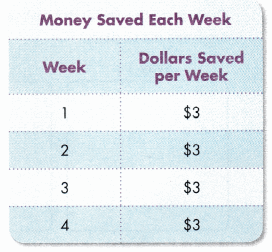
Use the Money Saved Each Week table to answer Exercise 1.
Question 1.
How much money has Jamie saved after 4 weeks? Write a multiplication equation to solve.
Answer:
The money Jamie saved after 4 weeks = $12.
Explanation:
In the above-given question,
given that,
Jamie saved in ist week = $3.
he saved in 2nd week = $3.
he saved in 3rd week = $3.
he saved in 4th week = $3.
3 + 3 + 3 + 3 = 12.
4 x $ 3 = $12.
so the money Jamie saved after 4 weeks = $12.
Use the Sticker Prices list to answer Exercises 2-4.
Question 2.
Jamie divides his money into two equal parts. Jamie spends 1 part on a sticker album. Which of the albums can Jamie buy?
Answer:
Jamies buy a green sticker album.
Explanation:
In the above-given question,
given that,
Jamie divides his money into two equal parts.
Jamie spends 1 part on a sticker album.
12 / 2 = 6.
the cost of the green sticker = $6.
so Jamies buy a green sticker album.
Question 3.
Jamie spends the other part of his money on stickers. How many stickers can Jamie buy?
Answer:
Jamie buys 3 stickers.
Explanation:
In the above-given question,
given that,
Jamie spends the other part of his money on stickers.
he buys 3 stickers for $1.
so Jamies buys 3 stickers.
Question 4.
After spending his money, Jamie decides that he wants a second album. He plans to save $3 per week until he can also buy a blue sticker album. How many weeks does Jamie need to save money?
Answer:
The number of weeks Jamie needs to save money = 3 weeks.
Explanation:
In the above-given question,
given that,
Jamie decides that he wants a second album.
He plans to save $3 per week.
the second album is the blue album.
the blue album costs $9.
so he wants to save 3 weeks.
3 + 3 + 3 = 9.
Use the Sticker Arrays table to answer Exercise 5.
Question 5.
Jamie wants to organize his stickers into arrays on a page of the album. Jamie started to make a table to show three ways he could do this.

Part A
Draw arrays to show the two ways Jamie planned to organize his stickers.
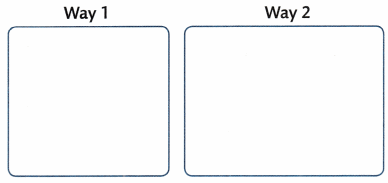
Part B
Draw an array to show another way Jamie could organize his stickers.
Complete the Sticker Arrays table for Way 3.

Answer:
A. 6 x 3 and 2 x 9.
B. 3 x 6.
Explanation:
In the above-given question:
given that,
in way 1 number of rows = 6.
number of columns = 3.
6 x 3 = 18.
in way 2 number of rows = 2.
the number of columns = 9.
2 x 9 = 18.
in way 3 number of rows = 3.
number of columns = 6.
3 x 6 = 18.

Question 6.
Write multiplication equations for each array to check that Jamie uses all of his stickers in each plan. Are there two ways that show the same factors? Explain.
Answer:
Yes, there are two ways that show the same factors.
Explanation:
In the above-given question,
given that,
way 1 and way 2 are the same.
3 x 6 and 6 x 3.
3 x 6 = 18.
3 and 6 are the factors.
6 x 3 = 18.
6 and 3 are the factors.
so there are two ways that show the same factors.
